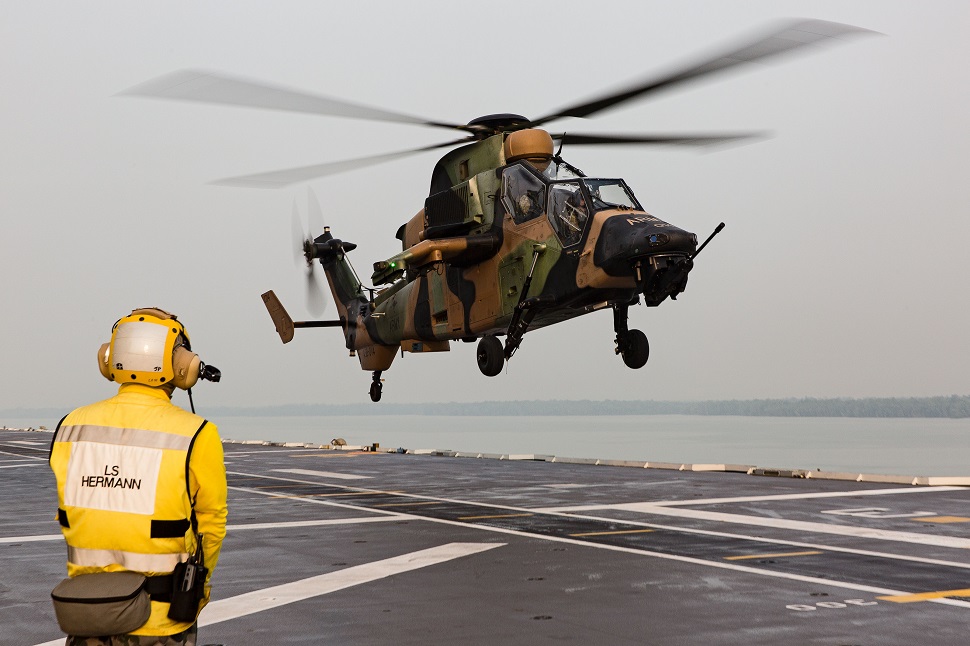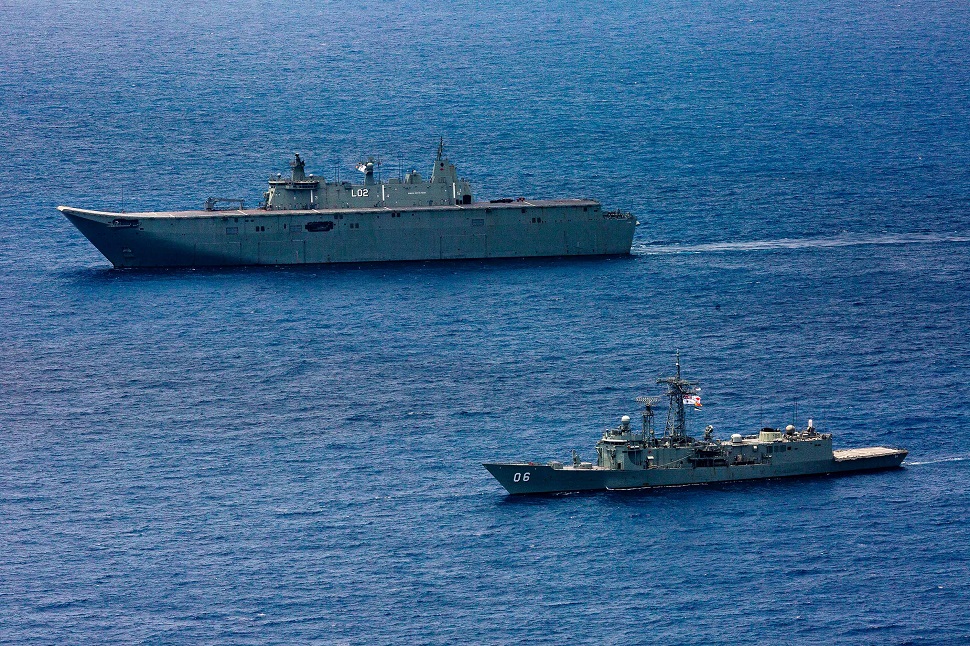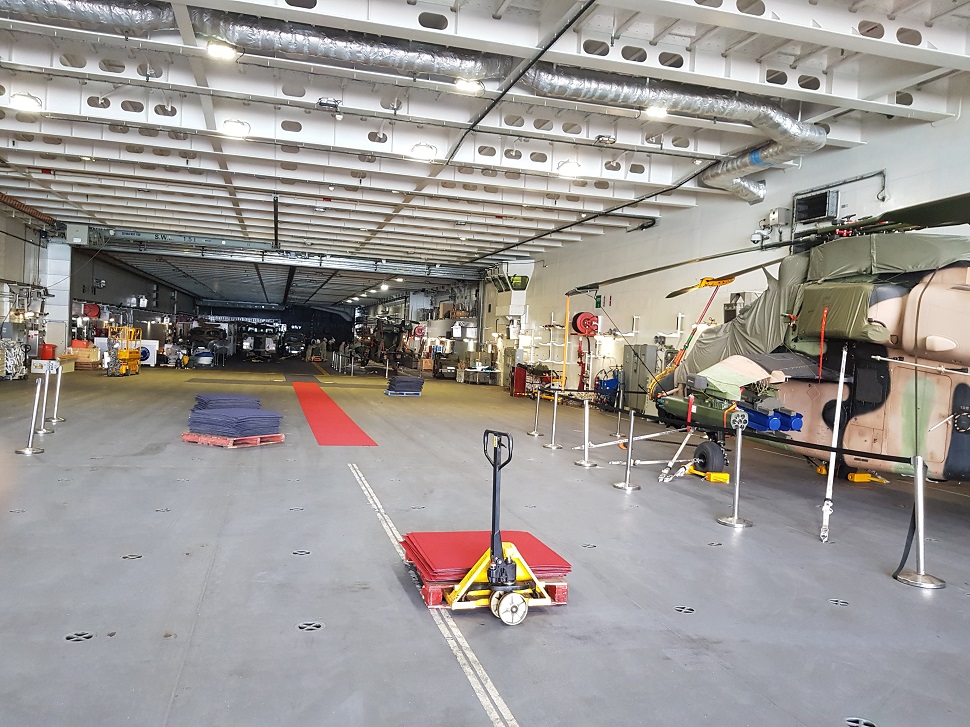The Australian Army has entered a new era with the deployment of four Airbus Helicopters Tiger armed reconnaissance helicopters (ARH) aboard the navy's HMAS Canberra as part of the vessel’s voyage through Southeast Asia.
While the deployment marks the third time that the combat rotorcraft has been operated from the Canberra, it is the first occasion that an operational unit has done so. With 80 army personnel – of whom 12 are flight crew – the army and navy are focused on developing a seaborne attack helicopter capability.
FlightGlobal toured the Canberra recently as it visited Singapore as part of the Biennial IMDEX naval show. It was among a flotilla of some two dozen warships, also including the JS Izumo – a "flat-top" that Japan will upgrade for operations with the Lockheed Martin F-35B.
For the Southeast Asia cruise, the Australian vessel also carries a pair of NH Industries MRH90 helicopters.

Royal Australian Navy
The Tigers did not originally deploy with the ship when it sailed from Australia. Instead, they were transported from their base in Darwin to Kuala Lumpur’s Subang International airport in Malaysia aboard Royal Australian Air Force (RAAF) Boeing C-17s. The strategic transport can accommodate two of the helicopters, in addition to other equipment and personnel. The ARHs were then flown to the ship in Port Klang.
Lieutenant Colonel Dan Bartle is commanding officer of the army's 1st Aviation Regiment, which includes the 162nd Attack Squadron from which the four Tigers and their personnel are drawn. While he is embarked primarily in a supervisory role, he has long experience as a Tiger pilot.
“You won't find too many pilots who dislike the Tiger,” he says. “Maintainers love it as well, as do the guys who re-arm and refuel it for us.”
Bartle has spent his career in the army, and this is the first time he has deployed aboard Canberra.
Each with a displacement of 27,000t – greater than the UK Royal Navy's former Invincible-class aircraft carriers – the Canberra and sister ship HMAS Adelaide can deploy over 1,000 personnel by helicopters or landing craft that launch from its well dock. A long, steep ramp and an elevator allows vehicles such as trucks and jeeps to travel between the well dock and the vessel’s large hangar deck.
Roughly half the hangar deck is earmarked for helicopters, with the remainder for vehicles. Two elevators provide access to the flightdeck, with the largest able to accommodate a Boeing CH-47 Chinook transport helicopter.
Given their size, the elevators can easily accommodate the much smaller Tigers, even with their rotor blades unfolded. However, the blades are kept folded when the helicopters are being moved within the hangar. Bartle says that procedures and processes for moving the ARH around the ship are quite advanced, following previous trial work.

Royal Australian Navy
Canberra's flight deck is 202m (662ft) long and 32m wide, with six helicopter landing spots. The navy says it can handle simultaneous take offs and landings for six MRH90s, or four Chinooks.
The vessel also features a ski-jump ramp. This is a vestige of the basis for the Canberra’s design: Spain's amphibious assault ship Juan Carlos I, which operates the Boeing AV-8B Harrier.
The retention of the ski-jump has in no small way contributed to speculation that Australia may one day operate the short take-off and vertical landing F-35B from its vessels. However, the more prosaic explanation is that it was simply cheaper to leave the ski-jump as opposed to engineering it out of the design. It is understood that it would take a large amount of work on the deck and other facilities to accommodate fighters.
Despite the ship’s size it can still be a very challenging work environment, packed as it is with troops, helicopters and vehicles. During FlightGlobal’s visit the Canberra was relatively quiet, with tour groups from other navies exploring the vessel, while the crew prepared for an evening reception. Bartle says it is a different story when flight operations are under way and especially when the ship is offloading troops from its well dock.
“When we're offloading it can be extremely noisy and busy,” he says. “You could be run over and not even be noticed. It's potentially very dangerous.”
One challenge involves conducting flight operations while the well dock is open to embark or disembark troops.

Royal Australian Navy
"It's super-complex for the ship, because obviously the ideal conditions for the back [of the ship] and well dock are that there aren't giant waves crashing in, and that must be balanced against our needs to take off and land, so that we can simultaneously conduct surface assault and air assault. That's the art.”
Flight operations from the ship are a complicated ballet. A big focus of the current deployment is working with weapons on the deck. A typical load-out for the Tiger’s four hardpoints comprises launchers for 7.62in unguided rockets, four Lockheed Martin AGM-114 Hellfire air-to-surface missiles and a fuel tank.
This configuration provides a 3h endurance and offers the means to engage “soft” targets such as personnel and most vehicles with the ARH's gun or rockets, along with "hard" targets, such as main battle tanks, with the Hellfire.
In response to a question about using the ARH's 30mm cannon to engage a tank, Bartle says: “I'd think you'd create difficulties for them in sights, sensors, and aerials, but you don't bring a knife to a gun fight. That's what the Hellfires are for.”
Apart from attacking targets on land, Bartle adds that the Tiger would also be an effective way for a large ship such as the Canberra to observe and, if necessary, engage small boats.
The joint army-navy team has practised taking weapons from a magazine deep inside the ship and moving them up to the flightdeck where they are loaded. The team in charge of the flightdeck must remain aware of which aircraft are coming in and departing, and their specific requirements.
A flight of three Tigers returning from a mission, for example, will need to be quickly refuelled and rearmed. It is key to have deck personnel briefed, and for weapons and fuel to be ready. There could also be a change of flightcrew. In such a scenario the weapons are loaded first, followed by fuel, with the crew swapped last.
When Tigers were first embarked the time for this exercise was 90min, but with practice this has been reduced to 30min – roughly the same time that the activity requires while operating on land.

Greg Waldron/FlightGlobal
Another area where standard operating procedures are being developed is how to safely deal with a piece of live ordnance that has malfunctioned and failed to detach from a returning Tiger.
It is also important to look after the deck crew’s wellbeing. In tropical waters off North Australia and in Southeast Asia the flight deck can get extremely hot. Bartle says the heat is especially searing when the ship is under way and travelling with the wind. To help with this, the ship has powerful air-conditioning in most compartments. This includes a break room just off the flight deck where the flight crew can cool off. There also are plenty of drinking fountains located around the ship.
Training crews to work in such an environment safely takes several weeks. A day after FlightGlobal’s visit, two sailors were due to take a final exam that involved dealing with a simulated helicopter crash on the ship’s deck. Only after passing will they be allowed to work on the flight deck without supervision.
On the cruise the Tigers are “flying every available day,” says Bartle. That said, even the Australian navy and army are subject to the well-known challenges of operating rotorcraft in Southeast Asia.
“We fly every day we are able,” he says. “It's a very complex air space and sea space, so we've appreciated the support from the commanding officer of the ship and of his crew to give us the flying window. Obviously, there are territorial waters… it's quite a difficult part of the world to just take off and fly on a given day, owing to the convergence of territorial waters and airspace."
Based in Darwin, Northern Territory, Australia’s 22-strong Tiger fleet is used to operating in hot, challenging conditions. However, a shipborne deployment adds an extra corrosion concern. No significant maintenance issues with the Tiger have been observed due to sea operations, although the type's cannon – which is made of metal – has required more work than normal.
Bartle says the size of Australia’s military means that joint operations are essential, and believes that every member of the nation’s army will at some point serve on a naval vessel.
“We work together, have a go, debrief it, improve systems, and then try again,” he says.
Source: FlightGlobal.com


























